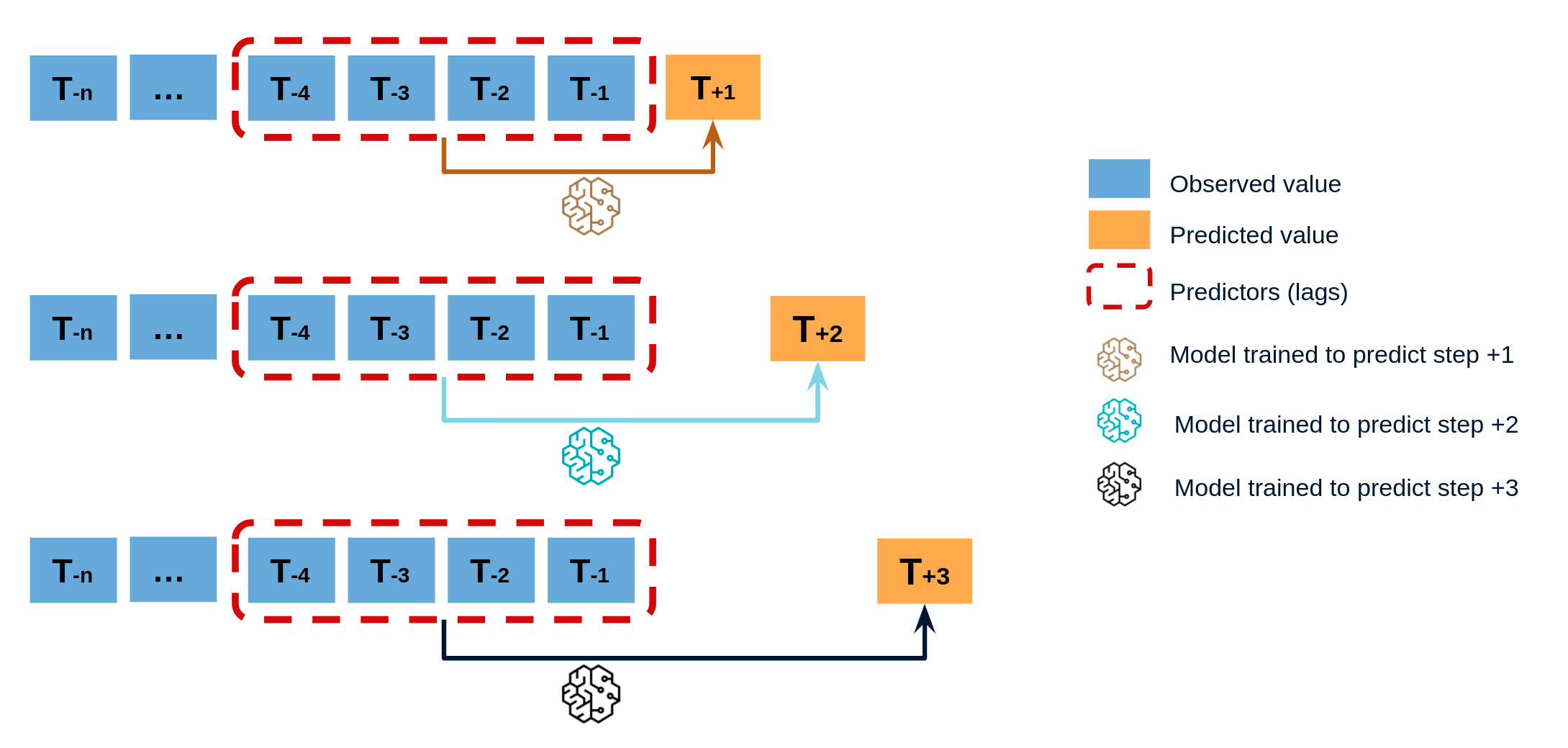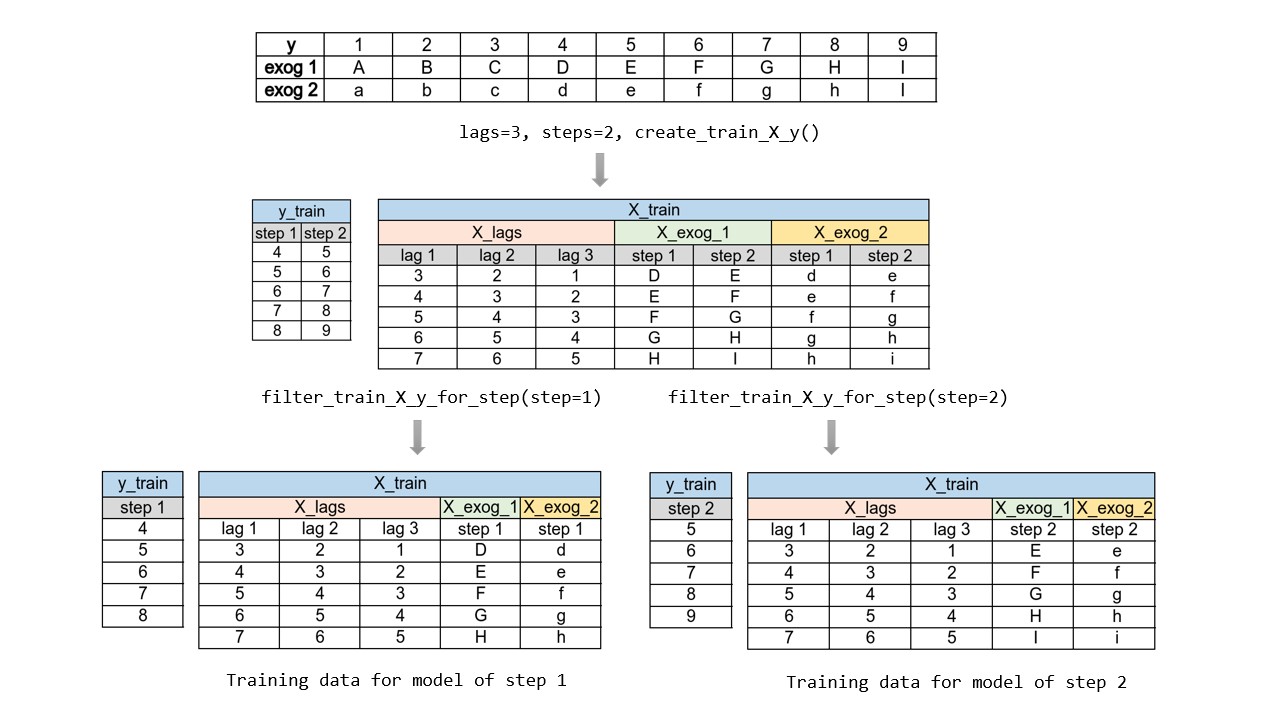Direct multi-step forecaster¶
This strategy, commonly known as direct multistep forecasting, is computationally more expensive than the recursive since it requires training several models. However, in some scenarios, it achieves better results. This type of model can be obtained with the ForecasterAutoregDirect class and can also include one or multiple exogenous variables.
Direct multi-step forecasting is a time series forecasting strategy in which a separate model is trained to predict each step in the forecast horizon. This is in contrast to recursive multi-step forecasting, where a single model is used to make predictions for all future time steps by recursively using its own output as input.
Direct multi-step forecasting can be more computationally expensive than recursive forecasting since it requires training multiple models. However, it can often achieve better accuracy in certain scenarios, particularly when there are complex patterns and dependencies in the data that are difficult to capture with a single model.
Direct multi-step forecasting can be performed using the ForecasterAutoregDirect class, which can also incorporate one or multiple exogenous variables to improve the accuracy of the forecasts.

To train a ForecasterAutoregDirect a different training matrix is created for each model.

Libraries¶
# Libraries
# ==============================================================================
import numpy as np
import pandas as pd
import matplotlib.pyplot as plt
from skforecast.ForecasterAutoregDirect import ForecasterAutoregDirect
from sklearn.linear_model import Ridge
from sklearn.metrics import mean_squared_error
Data¶
# Download data
# ==============================================================================
url = (
'https://raw.githubusercontent.com/JoaquinAmatRodrigo/skforecast/master/'
'data/h2o.csv'
)
data = pd.read_csv(url, sep=',', header=0, names=['y', 'datetime'])
# Data preprocessing
# ==============================================================================
data['datetime'] = pd.to_datetime(data['datetime'], format='%Y/%m/%d')
data = data.set_index('datetime')
data = data.asfreq('MS')
data = data['y']
data = data.sort_index()
# Split train-test
# ==============================================================================
steps = 36
data_train = data[:-steps]
data_test = data[-steps:]
# Plot
# ==============================================================================
fig, ax = plt.subplots(figsize=(6, 3))
data_train.plot(ax=ax, label='train')
data_test.plot(ax=ax, label='test')
ax.legend();
Create and train forecaster¶
# Create and fit forecaster
# ==============================================================================
forecaster = ForecasterAutoregDirect(
regressor = Ridge(),
steps = 36,
lags = 15
)
forecaster.fit(y=data_train)
forecaster
=======================
ForecasterAutoregDirect
=======================
Regressor: Ridge()
Lags: [ 1 2 3 4 5 6 7 8 9 10 11 12 13 14 15]
Transformer for y: None
Transformer for exog: None
Weight function included: False
Window size: 15
Maximum steps predicted: 36
Exogenous included: False
Type of exogenous variable: None
Exogenous variables names: None
Training range: [Timestamp('1991-07-01 00:00:00'), Timestamp('2005-06-01 00:00:00')]
Training index type: DatetimeIndex
Training index frequency: MS
Regressor parameters: {'alpha': 1.0, 'copy_X': True, 'fit_intercept': True, 'max_iter': None, 'positive': False, 'random_state': None, 'solver': 'auto', 'tol': 0.0001}
fit_kwargs: {}
Creation date: 2023-05-19 20:59:23
Last fit date: 2023-05-19 20:59:23
Skforecast version: 0.8.0
Python version: 3.9.13
Forecaster id: None
Prediction¶
When predicting, the value of steps must be less than or equal to the value of steps defined when initializing the forecaster. Starts at 1.
If
intonly steps within the range of 1 to int are predicted.If
listofint. Only the steps contained in the list are predicted.If
Noneas many steps are predicted as were defined at initialization.
# Predict
# ==============================================================================
# Predict only a subset of steps
predictions = forecaster.predict(steps=[1, 5])
display(predictions)
2005-07-01 0.952051 2005-11-01 1.179922 Name: pred, dtype: float64
# Predict all steps defined in the initialization.
predictions = forecaster.predict()
display(predictions.head(3))
2005-07-01 0.952051 2005-08-01 1.004145 2005-09-01 1.114590 Name: pred, dtype: float64
# Plot predictions
# ==============================================================================
fig, ax = plt.subplots(figsize=(6, 3))
data_train.plot(ax=ax, label='train')
data_test.plot(ax=ax, label='test')
predictions.plot(ax=ax, label='predictions')
ax.legend();
# Prediction error
# ==============================================================================
predictions = forecaster.predict(steps=36)
error_mse = mean_squared_error(
y_true = data_test,
y_pred = predictions
)
print(f"Test error (mse): {error_mse}")
Test error (mse): 0.008419597278831967
Feature importances¶
Since ForecasterAutoregDirect fits one model per step, it is necessary to specify from which model retrieves its feature importances.
forecaster.get_feature_importances(step=1)
| feature | importance | |
|---|---|---|
| 0 | lag_1 | 0.139299 |
| 1 | lag_2 | 0.051089 |
| 2 | lag_3 | 0.044192 |
| 3 | lag_4 | -0.019868 |
| 4 | lag_5 | -0.017935 |
| 5 | lag_6 | -0.013233 |
| 6 | lag_7 | -0.021063 |
| 7 | lag_8 | -0.012591 |
| 8 | lag_9 | 0.011918 |
| 9 | lag_10 | 0.020511 |
| 10 | lag_11 | 0.154030 |
| 11 | lag_12 | 0.551652 |
| 12 | lag_13 | 0.057513 |
| 13 | lag_14 | -0.071071 |
| 14 | lag_15 | -0.035237 |
Extract training matrices¶
Two steps are needed to extract the training matrices. One to create the whole training matrix and a second one to subset the data needed for each model (step).
# Create the whole train matrix
X, y = forecaster.create_train_X_y(data_train)
# Extract X and y to train the model for step 1
X_1, y_1 = forecaster.filter_train_X_y_for_step(
step = 1,
X_train = X,
y_train = y,
)
X_1.head(4)
| lag_1 | lag_2 | lag_3 | lag_4 | lag_5 | lag_6 | lag_7 | lag_8 | lag_9 | lag_10 | lag_11 | lag_12 | lag_13 | lag_14 | lag_15 | |
|---|---|---|---|---|---|---|---|---|---|---|---|---|---|---|---|
| datetime | |||||||||||||||
| 1995-09-01 | 0.534761 | 0.475463 | 0.483389 | 0.410534 | 0.361801 | 0.379808 | 0.351348 | 0.336220 | 0.660119 | 0.602652 | 0.502369 | 0.492543 | 0.432159 | 0.400906 | 0.429795 |
| 1995-10-01 | 0.568606 | 0.534761 | 0.475463 | 0.483389 | 0.410534 | 0.361801 | 0.379808 | 0.351348 | 0.336220 | 0.660119 | 0.602652 | 0.502369 | 0.492543 | 0.432159 | 0.400906 |
| 1995-11-01 | 0.595223 | 0.568606 | 0.534761 | 0.475463 | 0.483389 | 0.410534 | 0.361801 | 0.379808 | 0.351348 | 0.336220 | 0.660119 | 0.602652 | 0.502369 | 0.492543 | 0.432159 |
| 1995-12-01 | 0.771258 | 0.595223 | 0.568606 | 0.534761 | 0.475463 | 0.483389 | 0.410534 | 0.361801 | 0.379808 | 0.351348 | 0.336220 | 0.660119 | 0.602652 | 0.502369 | 0.492543 |
y_1.head(4)
datetime 1995-09-01 0.568606 1995-10-01 0.595223 1995-11-01 0.771258 1995-12-01 0.751503 Freq: MS, Name: y_step_1, dtype: float64
%%html
<style>
.jupyter-wrapper .jp-CodeCell .jp-Cell-inputWrapper .jp-InputPrompt {display: none;}
</style>